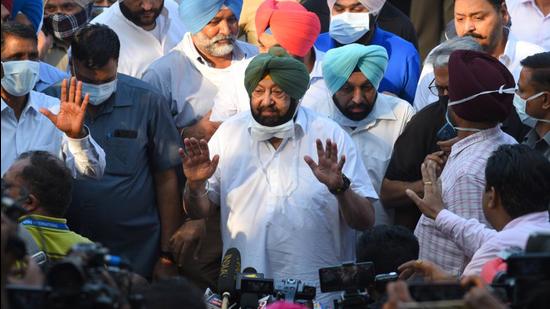In Indian politics, the challenge of transition
In the absence of inner-party democracy, arriving at a fine balance between gen-next aspirations and an ageing political leadership seems difficult. In politics, the premium placed on experience and stature makes it even more problematic to bring about any overnight change. But there is a way out
Retire when people ask why and not when they ask why not,” is a memorable quote attributed to cricketing great Vijay Merchant, who called it a day after scoring a masterful century against an English side in 1951.

Timing your retirement right is never easy, but at least in cricket, there is a selection committee that can nudge you to call it quits. In politics, on the other hand, there is neither a retirement age nor an institutionalised mechanism to facilitate a smooth transition to a new order. As a result, ensuring a generational change remains one of the biggest challenges in Indian politics.
Take the recent political upheaval in Punjab, where a 79-year-old chief minister (CM) was virtually forced out of office in far-from-ideal circumstances. In 2017, Captain Amarinder Singh claimed he was fighting his last election. Then, earlier this year, he suddenly changed his mind, insisting that he would continue to “serve the people”. By the end, an increasingly inaccessible Captain resembled a forlorn general, disconnected from his legislators and the people, and yet unwilling to withdraw from the political battlefield, pushing the Congress leadership into a difficult situation where the party dithered for months before finally showing him the door.
Singh is not the only Congressman wanting to cling to power after a long innings. In Rajasthan, 70-year-old Ashok Gehlot is a three-time CM but will not cede an inch of space to his much younger rival, Sachin Pilot. In Uttarakhand, a 73-year-old Harish Rawat is still hoping to be the party’s face in next year’s election. In Haryana, the 74-year-old two-time former CM, Bhupinder Singh Hooda, is still dreaming he can pull off a hat-trick. In Madhya Pradesh, the Kamal Nath-Digvijaya Singh duo, both in their mid-70s, tried to squeeze out the youthful Jyotiraditya Scindia from the power equations. The Congress Working Committee has several septuagenarians and even the odd octogenarian in its ranks.
The Bharatiya Janata Party (BJP)’s age predicament wasn’t too different from the Congress till Prime Minister (PM) Narendra Modi dramatically arrived on the scene seven years ago. One of the new PM’s first acts was to create a margdarshak mandal, a body of “eminent leaders” to guide the party leadership. It was designed to keep out the previous generation of leaders from all the BJP’s core decision-making bodies. At the time, what was labelled a retirement home was seen as a shabby, disrespectful way of treating those who had devoted their lives to the party, including Modi’s mentor, LK Advani.
Seven years on, the idea is slowly beginning to make sense. By effectively putting a 75 years cut-off date for senior leaders, the BJP has effected a generation change within the party hierarchy without too much resistance. Every BJP CM across states is now under 70, many in their 50s while the likes of Devendra Fadnavis and Yogi Adityanath became CMs in their 40s. The one exception to the rule was BS Yediyurappa, 78, who was forced to step down last month.
Modi’s status as the BJP’s unquestioned supreme leader vests in him unbridled power, as witnessed in the surgical strike on the Gujarat cabinet last week. A less-domineering leader would have struggled with the pulls and pressures of party factionalism as a weakened Congress leadership has realised in recent times. Only an imperious high command where the lines between decisiveness and dictatorial behaviour are blurred has the capacity to ease out the old guard without demur.
Interestingly, regional parties, which increasingly resemble tightly controlled family-run businesses, are controlled by leaders who will not retire or give way easily to even their children. The indefatigable Sharad Pawar at 80 remains the Nationalist Congress Party’s tallest leader. For almost half a century, M Karunanidhi was the Dravida Munnetra Kazhagam mascot. It is only illness that has almost forced Mulayam Singh and Lalu Prasad to relinquish power to the next generation of Yadav leaders. In Odisha, the 75-year-old visibly tiring Naveen Patnaik remains the Biju Janata Dal’s solitary figure, with no clarity yet on who will succeed him.
In the absence of inner-party democracy, arriving at a fine balance between gen-next aspirations and an ageing political leadership seems difficult. In politics, the premium placed on experience and stature makes it even more problematic to bring about any overnight change. Here are a few practical suggestions to break the geriatric deadlock. One, introduce a legislative amendment by which there are term limits — say a maximum of four to five terms for any Member of the Legislative Assembly or Member of Parliament. Two, have a rotational policy for leadership positions in any party organisation. No individual, for example, can be party president for more than two terms up to a maximum of four years each. Three, have a one-person-one post principle at all levels, including party committees.
Four, ensure that at least half the election tickets must be mandatorily given to individuals below the age of 50. And five, create a political mentorship structure that promotes a healthy, less-fractious relationship between generations.
Which party will show the gumption to bite the bullet before it is too late? Or does eternal power remain the ultimate elixir of life?
Postscript: Since the margdarshak mandal concept is seen as one possible way in which to usher in a generational shift, here is a key question: Will Mr Modi, who turns 75 in 2025, apply the same retirement rule to himself? Or will he, like Captain Amarinder Singh and many others, insist on continuing to “serve the people” in perpetuity?
Rajdeep Sardesai is a senior journalist and authorThe views expressed are personal
Continue reading with HT Premium Subscription





